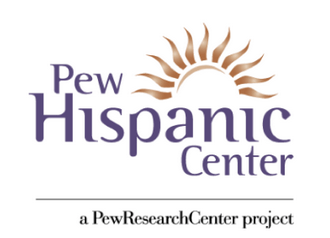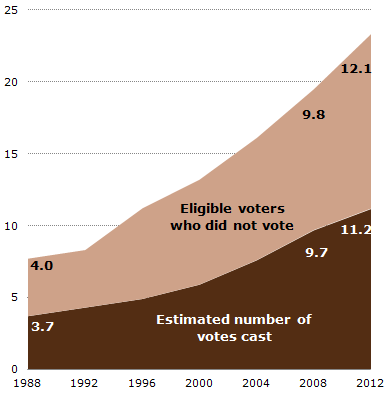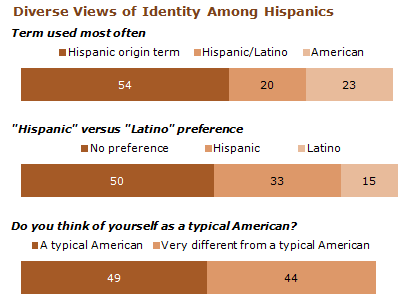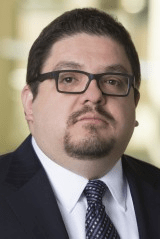During my one-on-one interview with Mark Hugo Lopez, we discussed a variety of topics regarding Hispanics in America, education, politics and current trends that are shaping America from a demographic to a social standpoint.
This blog is a continuation of my one-on-one interview with Mark Hugo Lopez, Director of Hispanic research at the Pew Research Center.
Natasha (Nativa): Are age or geographic location influential factors in social trends? And, is there any correlation among these?
Mr. Lopez: In terms of geography, the Hispanic population in the United States has become much more dispersed. Some of the fastest growing places are actually in the Southeast. Georgia, for example, is the 10th largest Hispanic state by population. Now what’s surprising is that it’s just behind New Mexico, one of the older well established Hispanic states. In fact, it’s the only other state besides California where Hispanics are the single largest racial or ethnic group. Georgia’s story really is a reflection of where there’s been a lot of growth in the Hispanic population. Atlanta is one of the fast growing Latino populations, as are some of the rural parts of Georgia. It’s not just limited to Georgia, the same thing is happening in Alabama, in Tennessee, in Kentucky, and in North Carolina. These are all places where over the last 20 years the Hispanic population has really grown.
Contrast that with the age of Latinos or the distribution by age. One of the big things that I think is important to note about the Latino community is that it has such a bulge of young people who are under the age of 18. Every year about 800,000 young Latinos come of age. So when you’re talking about the Latino adult population in the U.S., young people are playing a significantly larger role than they did just a few years ago in shaping everything from politics and engagement, to the languages they speak, to attitudes about a number of different things. For example, it’s interesting to see how Latinos that are younger look a lot like other young people in so many different respects, whether its religious affiliation, or even politics,. When we take a look at the community, there are connections to geography and age particularly because many of the youngest Latino populations are out west in places like California and Texas where Mexicans are largely driving these numbers. In south Florida on the other hand, the Cuban population, which is the dominant population in south Florida, is a much older population. Its median age is 40. By comparison the median age for Mexicans is 25. That’s a huge difference and it really speaks to how important the youth is particularly for the Mexican part of the Hispanic world.
One other interesting thing about geography is that the mix of Latinos is different. For example, Los Angeles County has nearly 5 million Latinos. but it’s largely dominated by Mexicans. Contrast that with metropolitan areas of the East coast which are much more diverse in terms of their ethnic origins of Latinos. In Boston, Dominicans are the dominant group while in New Haven it’s Puerto Ricans. In New York City its Puerto Ricans and Dominicans, in Philadelphia it’s Puerto Rican, in Washington D.C. it’s Salvadorian, Miami is Cuban, and Orlando is Puerto Rican. As you can see there is this diversity up and down the east coast and frankly Atlanta is the only major U.S. city on the east coast where Mexicans are the dominant group. As opposed to out west where they are the dominant group virtually everywhere.
Natasha (Nativa): Being politically engaged is part of our genes as Latinos. We’re passionate about decision being made in our home countries. How important it is for US candidates to appeal to the Latino vote?
Mr. Lopez: I think it’s important to note how important the Latino vote has become in the nation’s elections. In 2012 there were 23.3 million Latinos who were at least 18 years of age and a U.S. citizen. That is a growth of almost 4 million people between 2008 and 2012. So the Latino electorate is growing quite quickly, faster than any other electorate. One other thing that is interesting is that we’ve seen a record turnout of Hispanics in each election cycle since the 1980’s. In 2008 for example, about 9.7 million Latinos voted. In 2012, 11.2 million Latinos voted, hitting record turnout each and every election cycle. It’s partly because the Latino vote has become important in battleground states such as Florida, Colorado, and Nevada. These are the places where the Latino vote is significant enough to have an impact on those election outcomes. Some analysts also even argue that some states like Ohio and Pennsylvania, which have relatively small Hispanic populations, will be an important part of determining the outcome of those elections.
For candidates, I think one of the things that you are starting to see is the importance of the Latino vote, one interesting thing is that while we’ve been hitting these records the turnout rate for Hispanics has been somewhat flat. It was about 49-50% in 2008; in 2012 it was 48%. So unlike African-Americans who have been participating at higher and higher rates, since the mid 90s we have seen the Hispanic participation rates growing some, but remaining relatively flat, at least in the last two elections. This is actually something that some folks say is a reason why candidates may not be reaching out to Latinos. Another thing about the Latino vote that is worth noting is that part of the reason for this lower voter turnout rate is where Latinos live. Half of the Latino voters are in two states – California and Texas – and neither one was a battleground state neither in 2012 nor in 2008. If it’s not a battleground state these states tend not to get the same amount of attention from candidates than places that are. Latinos may be 17% of the U.S. population, they may be about 11% or so of the electorate, but they only made up 8% of voters in 2012.
Natasha (Nativa): California is now the 2nd state where Latinos are the single largest ethnic group. What state does Pew estimate will be next?
Mr. Lopez: The next state will be Texas. Probably sometime in the next 5 to 10 years Texas will have the situation where Latinos will not be the majority, but will be the largest single racial or ethnic group. After Texas there’s going to be a long time, probably a decade or two, before the next state becomes one of these states where Latinos are the largest racial or ethnic group. Likely Arizona, it could be perhaps Nevada, it could be perhaps Florida. It depends on so many different things it’s hard to predict these things into the future, because a state’s population grows and declines or changes very easily because it’s easy to move from state to state. But California, crossing this line this month in some respects, its a reflection of the demographic future of the country.
Natasha (Nativa): Do you think that in California in particular, the Hispanic growth will continue?
Mr. Lopez: Oh yes! We will continue to see growth in California. Estimates of when California crosses this line are based off of the state demographer’s assessment of what’s happening. But it is interesting that California had predicted that this switch over would happen in July of 2013 and it didn’t because birth rates among Latinos unexpectedly declined a little bit.
One interesting thing about the U.S. Latino community is how big it is in comparison to other Latin American countries. The U.S. Latino community right now is at about 53 million. In fact, between 2000 and 2010 half of the United States population growth came from Hispanics. To put the U.S. Hispanic population in perspective, the size of Peru’s population is about 20-something million. Colombia and Argentina is somewhere in the 40s and Spain is almost 50 million people. But you look at the United States and its Hispanic population alone it is larger than the populations of any Latin American country with the exception of two, Mexico and Brazil. So putting that into perspective, the United States is one of the largest Spanish speaking countries in the world!
Natasha (Nativa): What’s the Latino identity today compared with 10 years ago and is social media influencing how we express our opinions?
Mr. Lopez: That’s a good question. First, let’s talk about identity because that can be so many different things. When we ask Hispanics about their identity and what terms they use to describe themselves, do they think of themselves as the typical American, do they see shared common values across the community in the United States, or perhaps shared common values with those back in the home country? We actually have not seen a lot of movement on these measures in 12 years of polling. For example, which term do Hispanics prefer – Hispanic or Latino? Most say they have no preference, they identify most often with their family’s ancestry. At the same time we are seeing a rising sense of identity with being American and so the second and third generation Latino is more likely than the immigrant Latino to say they most often call themselves an American, or call themselves an American first. That, I think, is a reflection of where we are going into the future. In terms of this notion of identity and sort of where Latino identity comes from and how social media plays into that, Latinos are using social media often times at the same rates or even higher rates than some other groups.
When we have published reports on Latino identity that usually draws a lot of conversations on social media about the pride that people feel about who they are and where they’re from. In some respects I think social media has been able to amplify this discussion about the differences of each person’s experience. People want to tell their stories. They want to talk about who they are and where they are from and social media has allowed them to do that. When we released a report on identity a few years ago I was really impressed with the reaction on Facebook and also just the reaction generally to the report. There were people telling us about their own personal backgrounds, where their families were from, and people wanted to talk about it.
Natasha (Nativa): What’s the future of the Latino community in the US?
Mr. Lopez: I think it’s a bright future in a number of respects. Our public opinion surveys show that Latinos see a bright future for themselves and for their children. They expect the standard of living for their children to be better than it is today. There is also a sense that things financially are going to get better and there’s a real belief that hard work matters Latinos in this respect are unique because most Americans don’t believe that. . The Latino future in the U.S. is a bright one and it’s not only a story of demographics, it’s also a story of how important the Latino youth are going to be in shaping the economy, in shaping education, and in shaping the way the U.S. interacts with the world. There are a lot of very hopeful signs such as the surge in college-going Latinos. In fact, they’ve been driving growth in enrollment in colleges and universities and now, with 2.5 million people, they are the largest minority group in the nation’s 2 year and 4 year college campuses. Just a few years ago that wasn’t the case. Not only is that happening, but greater shares of Latinos who graduate from high school are actually deciding to go to college. In fact, a greater share is doing this than among whites. So you see that Latinos are getting better prepared for future education, and more than ever are going to college. These signs all point to a preparation for an engagement that’ much a part of the American story of change, diversity, and growth.
Mark Hugo Lopez is director of Hispanic research. He studies the attitudes and opinions of Latinos, Hispanic views of identity, the political engagement of Latinos in the nation’s elections and Latino youth. Lopez also coordinates the Hispanic Trends Project’s National Survey of Latinos, an annual nationwide survey of Latinos. He was the research director of the Center for Information and Research on Civic Learning and Engagement (CIRCLE) as well as a research assistant professor at the School of Public Policy at the University of Maryland. Lopez received his doctorate in economics from Princeton University. He is an author of reports about the Hispanic electorate, Hispanic identity and immigration. Lopez frequently appears in national and international media in both Spanish and English.






